You probably have a good sense of how much risk you want to take on.
Maybe you are adventurous, hoping to make some really big gains, and prepared for the losses that might come your way.
Maybe you’re more cautious, preferring to know that your money isn’t at too much risk, and hoping for steady but less spectacular returns.
Or maybe you’re something in between.
Whatever your attitude to risk, the Saltydog system can work perfectly for you. And to help you with your risk management, we’ve set up some easy-to-use guidelines.
As you know from the different Saltydog groups, the more you invest in the Safe Haven and Slow Ahead groups (lowest volatility), the better you will sleep at night.
Conversely, the more you invest in Steady As She Goes (medium volatility) and the two Full Steam Ahead groups (high volatility), the more exciting, and also turbulent, life becomes.
In order to make it easy for you, we’ve created three model portfolios – low risk, medium risk and high risk – which specify what proportion of your money you should allocate to each of the Saltydog groups.
These three model portfolios are called the Tugboat (low risk/volatility), Ocean Liner (medium risk/volatility) and Speedboat (high risk/volatility).
Here they are:

By choosing the model that matches your level of risk tolerance, you ensure that your portfolio maintains the right balance of investments. (Otherwise known as ‘asset allocation’).
As you can see straight away, the Tug (lowest risk) has a very large percentage allocated to the low volatility Slow Ahead group: 70%. And it only has a small percentage allocated to the three high volatility groups – Full Steam Ahead Developed, Full Steam Ahead Emerging, and the ‘Specialist’ sector: just 10% for all three combined. This is what keeps it safer and more stable.
With the high risk Speedboat portfolio, the emphasis is the other way round. The Speedboat has a much higher proportion (50%) in the three high volatility groups, and a lower proportion in the low volatility groups (only 20% in Slow Ahead).
What is the “Specialist” sector?
The Specialist sector is one of the official Investment Association (IA) fund sectors. In the words of the IA, it contains funds that “are not accommodated by the mainstream sectors”. And we don’t assign it to any of our Saltydog groups – we consider it separately.
The Specialist sector includes funds that invest in areas such as gold, natural resources, agriculture, Latin America, Russia & Eastern Europe.
From the Saltydog perspective, the Specialist sector is risky and highly volatile, but it does provide some very interesting opportunities from time to time.
But what’s also very important to understand is that the percentage of our portfolio allocated to each of these groups is not fixed – it depends on the market situation.
Let me explain.
In a static asset allocation model, you would decide – for example – that you’d have 40% of your portfolio in UK shares, 40% in bonds, and 20% in cash. And these percentages would be fixed. You’d try to maintain them all the time, whatever the market was doing.
But with the Saltydog system, we are always responding to what the market is telling us – via our data. Nothing is static.
With each of the three model portfolios above, we have shown them in their most ‘adventurous’ states. These are the percentage allocations for when the market is in optimum conditions, with everything going smoothly and heading nicely upwards – meaning that the higher volatility groups will be clearly out-performing the lower volatility ones.
On the other hand, if market conditions become uncertain or more risky – i.e. the higher volatility groups are no longer out-performing - then the portfolio allocations become more conservative. We shift our money out of the more volatile, and into the less volatile groups.
Remember the key Saltydog principle:
You never invest in a more volatile sector, unless it’s showing significant out-performance relative to the less volatile sectors.
With the model portfolios, it works like this. Let’s take the Tugboat as our example.
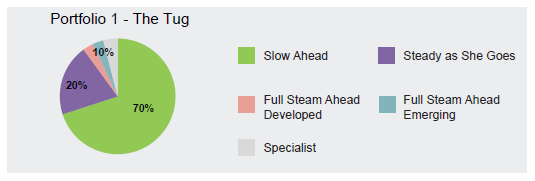
Tugboat portfolio: group allocations in optimum market conditions
These are the group allocations for the Tugboat portfolio in optimum market conditions:
- 70% in Slow Ahead
- 20% in Steady As She Goes, and
- 10% across the three most volatile groups – Full Steam Ahead Developed, Full Steam Ahead Emerging, and the Specialist sector.
(a) Markets doing badly
But let’s say that we’re not in optimum market conditions. We look at the Saltydog data and we see that – based on the 4-week trends - the sectors in the Slow Ahead group (the least volatile) are doing better than any of the other (more volatile) groups. Or, to put it the other way round, the more volatile groups are not outperforming the Slow Ahead group. What do we do now?
We certainly won’t be investing in the more volatile groups, because they’re not outperforming. So, as long as there is a decent performance to be achieved from the Slow Ahead group, we’ll put all our money into Slow Ahead:
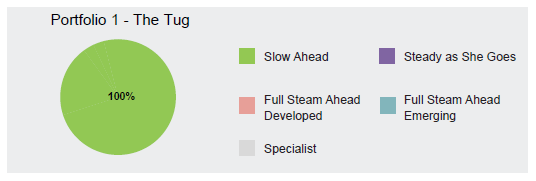
How does this follow from the optimum version of the Tugboat pie chart?
As we’ve seen from the previous pie chart above, the Tugboat allocation in optimum market conditions allows us to invest 30% of our money in groups that are more volatile than Slow Ahead - with 20% of our money in Steady As She Goes, and a further 10% in the three most volatile groups (Full Steam Ahead Developed, Full Steam Ahead Emerging, and the Specialist sector).
We are always happy to reduce our exposure to the more volatile sectors – because that means less risk, and our money being relatively safer. So if the more volatile sectors aren’t out-performing, it makes perfect sense to take the money allocated to them and invest it in less volatile sectors instead.
Therefore, in this instance, we take the 30% we could put in to the more volatile sectors, and allocate all of it to Slow Ahead sectors.
(b) Markets pick up
If the market starts to pick up and we begin to see out-performance by the more volatile sectors, then we will start to move our money into them.
Let’s assume that the sectors in the Steady As She Goes group are now outperforming the Slow Ahead group. Let’s also assume that the three most volatile Groups are not outperforming Steady As She Goes.
In this case we could allocate up to 30% of our money into Steady As She Goes:
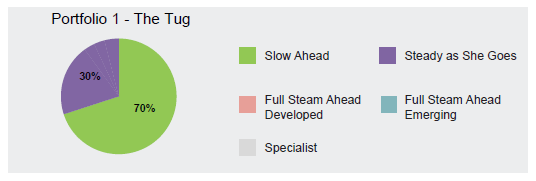
Since the three highest volatility groups are not out-performing Steady As She Goes, we can take the 10% allocated to them and assign it to Steady As She Goes, because it’s a lower volatility group. So 20% (the allocation to Steady As She Goes in optimum conditions) plus 10% equals 30%.
(c) Markets pick up further: optimum conditions
If the market picks up even further, and we see significant out -performance in the most volatile groups, we can then put some of our money into those. And thus we would end up with our money in the most aggressive arrangement of the Tugboat portfolio, like this:
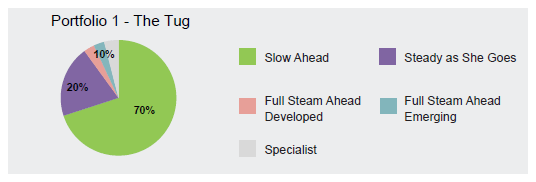
Here there’s 70% allocated to Slow Ahead, 20% allocated to Steady As She Goes, and 10% allocated across the three most volatile groups.
The key thing is that you never exceed the maximum allocations allowed for your exposure to more volatile groups.
For example, if you adopt the Tugboat portfolio, you will never allocate more than 10% of your money to the three most volatile groups – however well they are doing. If you’re only happy with the lower level of risk, which is what the Tugboat is designed for, you simply don’t want to take on more than 10% exposure to the groups with the highest levels of volatility.
With Steady As She Goes, here you could go up to a maximum of 30% exposure. (As we saw above). Never more than that, with the Tugboat, however well these sectors are performing.
And with Slow Ahead, as we’ve seen, you could be in a situation where 100% of your money is in this group.
(d) Other possible allocations
The examples I’ve given above show the ideal, logical progression. In other words, as the market picks up, the more volatile groups gradually start to out-perform – so we move from the Slow Ahead group, to the Steady As She Goes group, and finally to the three most volatile groups.
But, depending on how the various sectors are performing, it doesn’t always go in a perfectly neat progression – going up step-by-step through the more volatile groups.
Here’s another possibility.
Let’s say we have 80% of our money allocated to Slow Ahead, and 20% allocated to Steady As She Goes, like this:
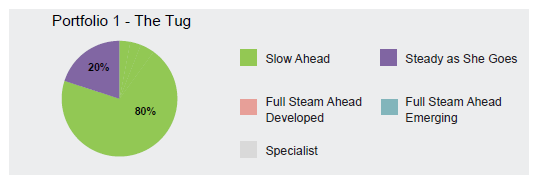
Now if the market picks up further, the next logical thing to do – based on the principles I’ve just explained - would be to increase our exposure to Steady As She Goes, up to the maximum of 30% that the Tugboat allows.
But let’s say that the higher volatility Full Steam Ahead group is flying along, and far out-performing the Steady As She Goes group. In this situation you could actually decide to move money into the Full Steam Ahead group before filling up the full Steady As She Goes allocation, like this:
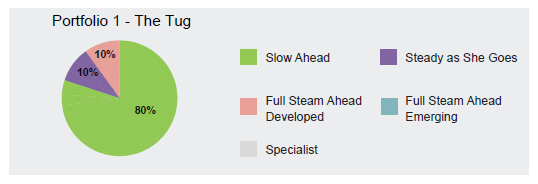
Here, because it’s out-performing so strongly, we’ve put 10% of our money into Full Steam Ahead Developed - even though we still have ‘only’ 10% of our money allocated to Steady As She Goes.
The key points are that:
- You only move into more volatile groups when their out-performance merits it, and
- Whichever portfolio you pick, you never exceed the maximum allocations for your exposure to the more volatile groups.
Exactly the same principles apply to the other portfolios - Ocean Liner and Speedboat
– but just using different percentages, giving you more exposure to the volatile groups.
(e) A complete market melt-down
Last of all, if there is a major crisis and the markets totally collapse – where even the Slow Ahead group is not showing a positive performance – then we would move our money into the Safe Haven group.
This is the equivalent of getting out of the stock market completely – effectively moving into cash. (See the note on Safe Haven in Why moving your money between sectors makes perfect sense).
Read next > PART 2 The principles: how Saltydog works

Comments
0 comments
Please sign in to leave a comment.